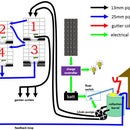Introduction: Viewable/Cleanable Solitary Bee Hotel
I made a cleanable/reusable/viewable solitary bee hotel for the garden. It allows you to see how many rooms have been used, and take it apart to clean for reuse next year.
Supplies
Scraps of untreated lumber, small sheets of glass, catch.
The lumber should be untreated to prevent damage to the grubs. Any treatment usually applied to wood is designed to kill grubs. The untreated lumber was from scraps I had lying around.
The small sheets of glass were from a broken pane of greenhouse glass. I cut it using a small diamond wheel. Get these from any hardware shop.
The catch I made from flat bar but could be any sort of catch which allows both doors to open/close at the same time.
Sizes here are approximate and I did a bit of bodging to make things fit snugly.
Step 1: Prepare Top, Back and Bottom Pieces of the Hotel
The top, back and bottom of the hotel is made from a single piece of untreated timber which has a channel cut into it, to a depth of approx. 6mm and almost the whole width.
It is easier to put the channel into a single long piece of timber first, and then cut it to size, than try and cut the channel into 3 separate smaller pieces.
Once the channel is cut, cut at 45° to create the top, back and bottom.
Step 2: Prepare Hotel Rooms Block
The central rooms block is cut to size, ensuring a snug fit once the glass panels have been inserted.
Do this before trying to cut the room channels in the next step. If not, the channels may have to be recut if you need to adjust the size of the rooms block.
Step 3: Create Rooms in Hotel
The central block (pink) has channels cut into it approx. 6mm wide and 6mm deep. This seems a useful size. You could experiment with different sizes. These channels could be cut either with a router or a table saw.
I alternated the channels on either side to avoid having thin pieces in the middle.
Step 4: Secure Hotel Pieces Together With Glass Windows
Once the central block fits snuggly with the glass windows in place, screw the top, back and bottom pieces into the central block. Do not use glue as you'll want to be able to take the hotel apart to be able to clean it.
The glass windows should not be secured with anything, but friction due to a snug fit. This again is for easy cleaning later.
Step 5: Make Viewing Doors
The easiest option is to make the doors in two pieces and then secure them together.
First piece is the inner one (light blue), which needs to fit snugly onto the glass so it blocks out the vast majority of any light.
The second piece (dark blue) is what forms the main part of the door, and which the hinge is attached.
Insert the inner door so it rests next to the glass. Add a piece of double sided tape to the outside of the inner door then place the outer door on top. The double sided tape should hold them together long enough for you to take both bits away and secure them together with screw or nails. Be careful not to leave anything sticking out of the inner door piece as it could risk breaking the glass.
I used some offcut of piano hinge, but any reasonably loose hinge will do. If the hinge is not loose it may seize during the season.
Step 6: Add Mounting Brackets
To mount the hotel outside, there needs to be support pieces at the back. These need to be thick enough to make sure the doors can open freely without interference. I simply used chunky scraps of wood on the back (purple)
Step 7: Add Door Catch
Final piece of the puzzle is to have some sort of locking mechanism to keep the doors securely closed, to keep the light out.
I used a piece of flat bar with screw in one end and a notch cut out if it in the other.
Step 8: Mount the Hotel Out of Sun and Rain
I’ve mounted my bee hotel under the eaves of a shed, as I didn’t want the hotel to be exposed to rain and/or baking sunshine. Once the bees have hatched next spring I’ll take it apart and give the channels a good cleanout with a wire brush, ready for the next batch.
Enjoy. Don't open the doors too often as this might put the bees off and/or expose the grubs to excessive changes in temperature.













